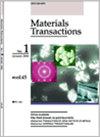镀锌钢在混凝土中的腐蚀机理研究
IF 1.9
4区 材料科学
Q4 MATERIALS SCIENCE, MULTIDISCIPLINARY
引用次数: 0
摘要
研究了热镀锌钢在含氯离子(Cl−)的饱和Ca(OH)2水溶液中的腐蚀行为和耐蚀性。在饱和的Ca(OH)2水溶液中,模拟混凝土孔隙中的水,在热镀锌钢表面形成Ca(Zn(OH)3)2·2H2O,起到保护膜的作用。而随着Cl−浓度的增加,锌的腐蚀速率加快。这可能是由于表面形成了Zn5(OH)8Cl2·H2O和CaCO3,而保护膜Ca(Zn(OH)3)2·2H2O的覆盖面积减小所致。而在混凝土中,循环腐蚀试验对热镀锌钢板的腐蚀没有促进作用。这可能是由于渗透到混凝土中的Cl−没有达到镀锌钢的深度,混凝土养护过程中形成的Ca(Zn(OH)3)2·2H2O在循环腐蚀试验后仍然存在。本文章由计算机程序翻译,如有差异,请以英文原文为准。
The Research of Corrosion Mechanism of Galvanized Steel in Concrete
The corrosion behavior and resistance of hot-dip galvanized steel were studied in a saturated Ca(OH)2 aqueous solution containing chloride ions (Cl−) in concrete. In the saturated Ca(OH)2 aqueous solution, which simulated water in the concrete pores, Ca(Zn(OH)3)2·2H2O was formed on the surface of the hot-dip galvanized steel, acting as a protective film. However, the corrosion rate of zinc increased as the Cl− concentration increased. This is presumed to be owing to the formation of Zn5(OH)8Cl2·H2O and CaCO3 on the surface and the decrease in the coverage of the protective film Ca(Zn(OH)3)2·2H2O. However, in concrete, the corrosion of hot-dip galvanized steel was not promoted by the cyclic corrosion test. This may be because the Cl− that penetrated into the concrete did not reach the depth of the galvanized steel and the Ca(Zn(OH)3)2·2H2O that was formed during the curing of the concrete remained after the cyclic corrosion test.
求助全文
通过发布文献求助,成功后即可免费获取论文全文。
去求助
来源期刊

Materials Transactions
工程技术-材料科学:综合
CiteScore
2.00
自引率
25.00%
发文量
205
审稿时长
2.7 months
期刊介绍:
Information not localized
 求助内容:
求助内容: 应助结果提醒方式:
应助结果提醒方式:


